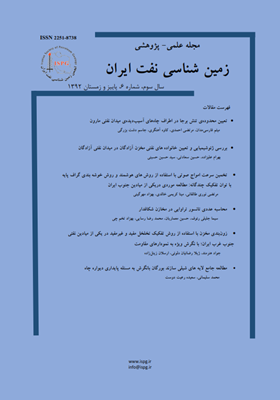محاسبه عددی تانسور تراوایی در مخازن شکافدار
محورهای موضوعی :
کلید واژه: مخازن شکافدار تانسور تراوایی شبکه شکستگی ناهمسانگردی تراوایی شبیه سازی جریان سیال ,
چکیده مقاله :
چکیده توسعه مناسب مخازن هیدروکربوری شکافدار به سرشت نمایی درست شکستگی ها بستگی دارد. توصیف خصوصیات وشبیه سازی این دسته از مخازن هیدروکربوری به دلیل ناهمگنی و ناهمسانگردی ذاتی در پارامتر های مخزنی مانند تراوایی، بسیار پیچیده و در عین حال ضروری می باشد. شبیه سازی مخازن شکافدار معمولا به روش های تخلخل دوگانه و یا تراوایی دوگانه انجام می شود. در این روش ها شکستگی ها به صورت الگوهای منظم فرض می شوند. برای رفع این مشکل در این مطالعه روش عددی برای محاسبه تانسور تراوایی در مخازن شکافدار ارائه شده است. در این روش خصوصیات شکستگی ها با جهت متفاوت و الگوهای نامنظم که در طبیعت بیشتر دیده می شود در نظر گرفته می شود. برای این منظور ابتدا یک شبکه شکستگی در دو بعد با توجه به مختصات ابتدا و انتها شکستگی ساخته شد، سپس با در نظر گرفتن مدل دو بعدی ریز دانه و تک فاز و در نظر گرفتن توزیعی از مشخصات شکستگی در شبکه ریز دانه و با اعمال شرایط مرزی مناسب، فشار و دبی در راستاهای مختلف محاسبه گردید. سپس با استفاده از رابطه دارسی المان های ماتریس تراوایی بدست آمد. نتایج به دست آمده از این روش با روش تحلیلی برای یک شکستگی در زوایای مختلف مقایسه شد و نشان داد که از دقت خوبی در محاسبه تانسور تراوایی برخوردار است. روش ارائه شده در محاسبه تانسور تراوایی سیستم شکستگی تصادفی که روش های تحلیلی در آن با محدودیت مواجه است با موفقیت عمل می کند.
Compressional and shear velocity are two fundamental parameters, which have many applications in petrophysical, geophysical, and geomechanical operations. These two parameters can be obtained using Dipole Sonic Imaging tool (DSI), but unfortunately this tool is run just in few wells of a field. Therefore it is important to predict compressional and shear velocity indirectly from the other conventional well logs that have good correlation with these parameters in wells without these logs. Classical methods to predict the mentioned parameters are utilizing correlations and regression analysis. However, the best tool is intelligent systems including Artificial Neural Network, Fuzzy Logic, Adaptive Neuro Fuzzy Inference System, and Multi resolution graph base clustering for performing such tasks. In this paper 1321 data points from Kangan and Dalan formations which have compressional and shear velocity are used. These data are divided into two groups: 995 and 326 data points were used for construction of intelligent systems and model testing, respectively. The results showed that despite differences in concept, all of the intelligent techniques were successful for estimation of compressional and shear velocities. The Multi resolution graph base clustering. The method had the best performance among the others due to precise clustering the data points. Using this method, the compressional and shear velocity were correlated with correlation factor of 0.9505 and 0.9407, respectively. The developed model does not incorporate depth or lithological data as a part of the inputs to the network. This means that utilized methodology is applicable to any field

